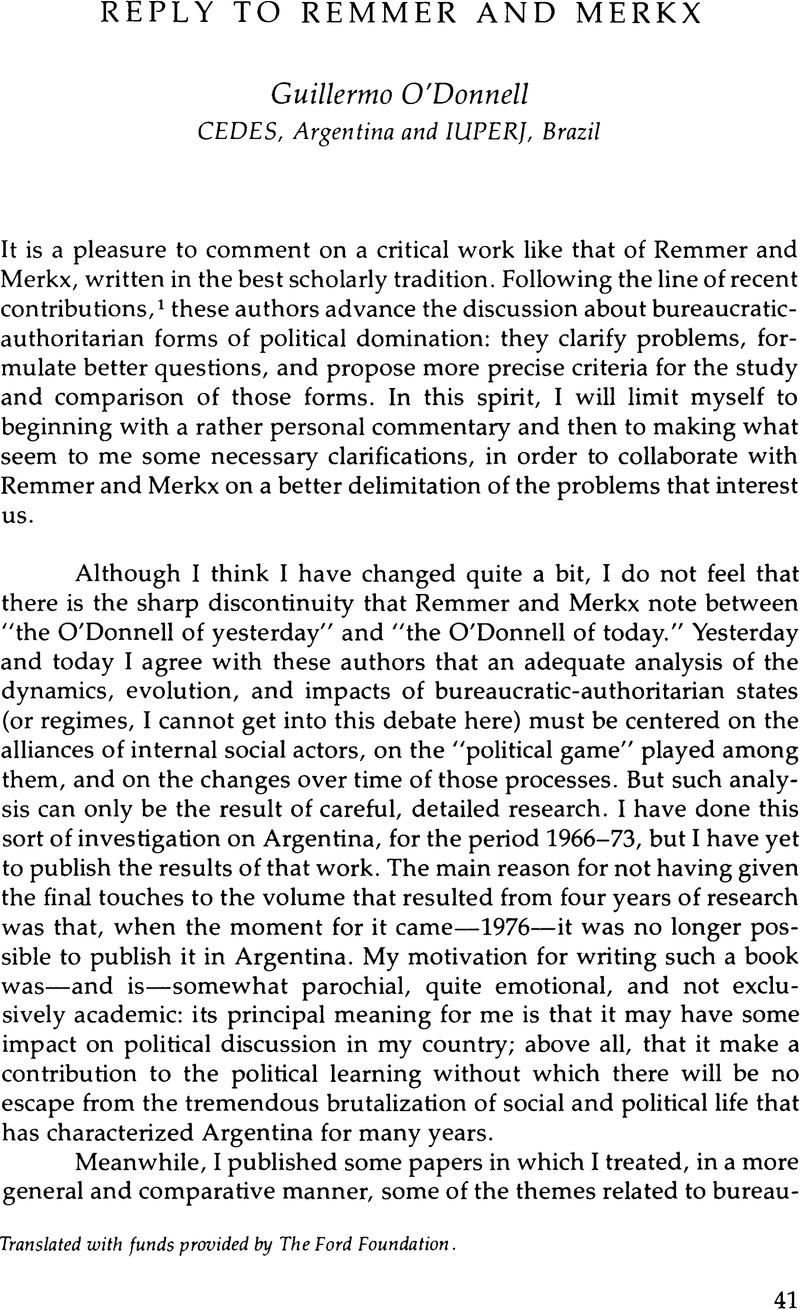Published online by Cambridge University Press: 24 October 2022

Translated with funds provided by The Ford Foundation.
* The page numbers that appear in brackets below refer to the Remmer and Merkx article in this issue.—Ed.
1. See, especially, David Collier, ed., The New Authoritarianism in Latin America (Princeton, N.J.: Princeton University Press, 1979); and Manuel A. Garretón, “En torno a la discusión sobre los regímenes autoritarios en América Latina,” Woodrow Wilson Center for International Scholars, Latin American Program, Washington, D.C., 1979.
2. Cf. “Reflections on the Patterns of Change in the Bureaucratic-Authoritarian State,” LARR 13, no. 1 (1978):3–38 and “Tensions in the Bureaucratic-Authoritarian State and the Question of Democracy,” in New Authoritarianism, pp. 283–318, where I state this, although I do not carry out the detailed analysis that follows from that statement. After the care that Remmer and Merkx have taken in studying most of my publications, I cannot reproach them for not having taken account of others in which I analyze themes that they point to as neglected in my work. With respect to the armed forces and their relationship with other actors, see “Modernization and Military Coups: Theory, Comparison and the Argentine Case,” in Abraham Lowenthal, ed., Armies and Politics in Latin America (New York: Holmes and Meier, 1976); with respect to the dynamics resulting from comparative differences (between Brazil and Argentina) in the economic and class structure, and the political resources of the popular sector and the bourgeoisie, “Estado y alianzas en la Argentina, 1956–1976,” published in Argentina as a CEDES Working Paper, 1977, and in Desarrollo Económico, December 1977 (the English version of this work is supposed to appear in a book resulting from a conference organized by the Center for Inter-American Relations in 1976, which has not yet been published); finally, more specifically on the bourgeoisie, “Notas para el estudio de la burguesía nacional en sus relaciones con el aparato estatal y el capital internacional,” Estudios CEDES, Buenos Aires, 1978.
3. Aside from the quite obvious case of Argentina, in an article to be published in the Journal of Inter-American Studies and World Affairs (“Labor-Industrial Conflict and the Collapse of Uruguayan Democracy”), Howard Handelman demonstrates the high degree of threat existing before the imposition of the present regime in Uruguay, which clearly places it within the “family” of those established in the 1970s. In line with my arguments, that author (based on data on strikes and the political role played by the labor unions) shows that, beside guerrilla activities, there was an important process of political activation of the popular sector, against which was directed a good part of the repression.
4. This useful distinction has been proposed by various authors; see, especially, Nicos Poulantzas, Las clases sociales en el capitalismo de hoy (Mexico, DF: Siglo XXI, 1974).
5. See Garretón, “En torno a la discusión.”
6. The discussion of this point is the central theme of “Estado y alianzas.”
7. Roberto Frenkel and Guillermo O'Donnell, “The ‘Stabilization Programs’ of the International Monetary Fund and Their Internal Impacts during Bureaucratic-Authoritarian Periods,” Latin American Program, The Wilson Center, Working Papers, no. 14, Washington, D.C., 1978.
8. In addition, the “anti-statist” fury, characteristic of the BAs of higher threat established in the 1970s, brought with it in Argentina, as well as in Chile and Uruguay, the loss, or the notable increase in cost, of access to services (transportation, education, health) which previously provided an important part of the real income of the popular sector.
9. My argument gains further plausibility when we consider the Argentine case. In 1966, the Argentine coup was, among all cases considered here, the one carried out in the most moderate conditions of threat. In 1976, the threat had reached levels similar to, or slightly lower than, those in Chile. I do not think that, as Remmer and Merkx argue, a different international situation can explain the important differences between the economic policies in post-1966 Argentina (whose numerous traces of heterodoxy were similar only to Brazil after 1964 and, above all, after 1968), and the much more orthodox one adopted following the coup of 1976.
10. See, especially, Frenkel and O'Donnell, “The ‘Stabilization Programs.‘”
11. For an elaboration of this and related points, see O'Donnell, “The Armed Forces and the Authoritarian State in the Southern Cone of Latin America,” paper delivered at the symposium organized in celebration of the twenty-fifth anniversary of the Armed Forces and Society Group, University of Chicago, October 1979.
12. See “Reflections.” Perhaps I should point out, for a proper interpretation of the issues discussed here with Remmer and Merkx, that I wrote that article in 1974, four years before its publication in English—as well as before the 1976 Argentine coup, the sharp authoritarian turn in Uruguay, and the adoption (in 1975) of highly orthodox policies in Chile.